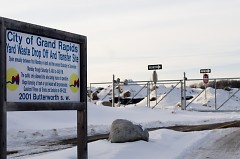Additional Information
Additional Information on snow disposal guidelines can be found here:

Domtar disposal site, located at 2001 Butterworth St SW /John Wiegand

Snow piles stored at Lincoln Park /John Wiegand
Additional Information on snow disposal guidelines can be found here:

Domtar disposal site, located at 2001 Butterworth St SW /John Wiegand
With one of the heaviest snowfalls on record it was not uncommon to see trucks filled with snow transporting it away from the city. However, these trucks have prompted some Grand Rapids citizens to question where all of the snow is headed.
"Do we have official 'snow dumps'? I ask because I saw a huge truck laden down with snow driving along 28th the other night, and it occurred to me if all that snow came from a parking lot, it was probably full of oil, gas, and who knows what else," asks Andy Westmoreland, a member of the Grand Rapids urbanist group, The Salon. "Obviously all that nastiness finds its way back into our water system via drainage anyway, but the thought of it actually being trucked and dumped somewhere seemed infinitely worse somehow."
While privately owned lots are responsible for their own snow removal, the city focuses its efforts on municipally owned infrastructure and buildings.
"When we do snow removal it is typically from the downtown area, the curbs, some of the bridges and sidewalk areas. We tend to haul that over to our Domtar Site on Butterworth [Street]," says James Hurt, Grand Rapids Director of Public Services.
The Domtar location offers a secure area to store excess snow from around the city and is monitored by the Michigan Department of Environmental Quality (MDEQ), according to Jim Arsulowicz, Parks, Cemeteries and Forestry Manager. The site is also open from early April through mid-December as a yard waste disposal site for area residents.
The city also uses parking lots in designated city parks, like Lincoln Park to store snow gathered from various municipal buildings.
The MDEQ's Water Resource Division recently published a Snow Disposal Guidance document focuses on the proper disposal of snow piles cleared from parking lots and city streets. These piles often contain concentrated level of contaminates including, road salt, sand, litter and potentially heavy metals, petroleum products and pesticides.
The report outlines some of the requirements for establishing buffer zones for snow disposal sites, along with tips to guide site selection. One of the MDEQ's suggestions states, "Avoid sites that may present risks for human exposure, like playgrounds and ballparks."
When asked about the MDEQ's suggestions Arsulowicz replied, "You know I have not heard of that. They are actually in the parking lot right now, which is pretty much closed and it is not in any of the sidewalks. If it does impede any travel, any pedestrians or if it becomes a problem, we will move it to our Domtar site."
According to Arsulowicz, the snow brought in from around city buildings to Lincoln Park was filtered of garbage and debris prior to it being hauled to the park. The city also takes measures to mitigate the effect of chemicals and debris on the water system as the snow begins to thaw.
"As it [the snowpack] melts we have buffer zones to make sure that it doesn't leech into any water system," says Arsulowicz. "We monitor it as it melts and if we see any type of debris or contamination, we take care of it immediately."
The Rapidian, a program of the 501(c)3 nonprofit Community Media Center, relies on the community’s support to help cover the cost of training reporters and publishing content.
We need your help.
If each of our readers and content creators who values this community platform help support its creation and maintenance, The Rapidian can continue to educate and facilitate a conversation around issues for years to come.
Please support The Rapidian and make a contribution today.